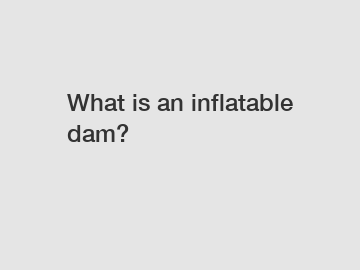What is an inflatable dam?
Inflatable dams are innovative structures designed to manage and control water levels in rivers, streams, and other bodies of water. Implementing inflatable dams can help regulate water flow, prevent flooding, facilitate water storage, enhance environmental conditions, and enable water-based recreational activities. This article explores the key features, advantages, and uses of inflatable dams.
**What is an Inflatable Dam?**.
An inflatable dam is a temporary or permanent barrier made of rubber, plastic, or fabric that can be inflated and deflated as needed to control the flow of water. These dams are typically filled with air or water to create a barrier across a river or stream. Inflatable dams have adjustable heights and can be customized to fit the specific requirements of a particular watercourse.

**Features of Inflatable Dams**.
Inflatable dams come in various sizes and configurations to suit different applications. They can be installed in a straight line or curved to accommodate bends in a river or stream. Some inflatable dams have a series of interconnected air chambers that allow for more precise control over water levels. Additionally, inflatable dams can be equipped with monitoring and control systems to automate the process of adjusting water levels.
**Advantages of Inflatable Dams**.
One of the primary advantages of inflatable dams is their versatility. They can be used in a wide range of settings, from small streams to large rivers, and can be installed temporarily or permanently. Inflatable dams are also cost-effective compared to traditional concrete or steel structures. They require less material and labor to install, can be reused multiple times, and have a lower environmental impact.
Inflatable dams are also environmentally friendly. They can be designed to allow for fish passage, sediment transport, and other ecological processes to continue uninterrupted. Inflatable dams can help restore natural river systems by creating pools and riffles that benefit aquatic habitats. They can also improve water quality by slowing down the flow of water and reducing erosion.
**Uses of Inflatable Dams**.
Inflatable dams have a wide range of applications in water management. They can be used to regulate water levels for irrigation, hydroelectric power generation, municipal water supply, and industrial processes. Inflatable dams are particularly useful for flood control, as they can be rapidly deployed to create temporary barriers in the event of heavy rainfall or snowmelt.
Inflatable dams are also popular in recreational settings. They can be used to create swimming areas, boating zones, and fishing ponds in rivers and lakes. Inflatable dams allow for the creation of water features such as waterfalls and rapids, enhancing the aesthetic and recreational value of water bodies. Additionally, inflatable dams can be used in conjunction with other water management structures, such as weirs and gates, to optimize water flow and storage.
In conclusion, inflatable dams are versatile, cost-effective, and environmentally friendly structures that offer numerous benefits for water management. Whether used for flood control, water storage, environmental restoration, or recreational purposes, inflatable dams are a valuable tool for managing and controlling water resources.
If you are interested in learning more about inflatable dams or exploring how they can benefit your water management project, please don't hesitate to contact us.
For more Rubber Dam China, Rubber Water Dam, pillow type rubber daminformation, please contact us. We will provide professional answers.

Comments
0